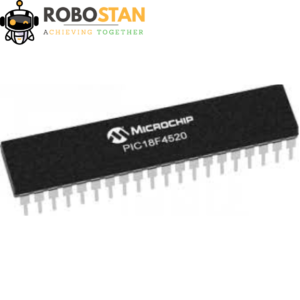
Based on 0 reviews
Be the first to review “PIC 16F73” Cancel reply
You must be logged in to post a review.
Related products
-
Micro Controllers
ATMEL ATmega8a Microcontroller Price in Pakistan
0 out of 5(0)The Atmel- AVR – ATmega8 is a low-power CMOS 8-bit micro-controller based on the AVR RISC architecture. By executing powerful instructions in a single clock cycle, the ATmega8 achieves throughputs approaching 1MIPS per MHz, allowing the system designer to optimize power consumption versus processing speed.
SKU: n/a₨480₨700 -
Micro Controllers
PIC18F4520-I/P 8-BIT PIC Microcontroller Price in Pakistan
0 out of 5(0)In terms of connectivity, the PIC18F4520 supports various communication protocols, making it suitable for interfacing with other devices and systems. Its robust set of I/O pins provides flexibility for connecting to sensors, displays, and other components. This microcontroller is commonly used in applications such as industrial control systems, home automation, robotics, and more. The PIC18F4520’s development ecosystem is well-established, with a variety of development tools, compilers, and libraries available to aid programmers. This makes it accessible to both beginners and experienced developers.
SKU: n/a₨2,000₨3,500 -
Micro Controllers
ATML – AVR AT Tiny 2313
0 out of 5(0)Special Microcontroller Features
- – debugWIRE On-chip Debugging
- – In-System Programmable via SPI Port
- – External and Internal Interrupt Sources
- – Low-power Idle, Power-down, and Standby Modes
- – Enhanced Power-on Reset Circuit
- – Programmable Brown-out Detection Circuit
- – Internal Calibrated Oscillator
SKU: n/a -
Micro Controllers
ATML – AVR AT Tiny 45
0 out of 5(0)Features
High Performance, Low Power AVR® 8-Bit Microcontroller
Advanced RISC Architecture – 120 Powerful Instructions – Most Single Clock Cycle Execution – 32 x 8 General Purpose Working Registers – Fully Static Operation
Non-volatile Program and Data Memories
- – 2/4/8K Bytes of In-System Programmable Program Memory Flash
- – 128/256/512 Bytes In-System Programmable EEPROM
- – 128/256/512 Bytes Internal SRAM
- – Programming Lock for Self-Programming Flash Program and EEPROM Data Security
Peripheral Features
– 8-bit Timer/Counter with Prescaler and Two PWM Channels
– 8-bit High Speed Timer/Counter with Separate Prescaler
- 2 High Frequency PWM Outputs with Separate Output Compare Registers
- Programmable Dead Time Generator
– USI – Universal Serial Interface with Start Condition Detector – 10-bit ADC
4 Single Ended Channels
2 Differential ADC Channel Pairs with Programmable Gain (1x, 20x)
Temperature Measurement
- – Programmable Watchdog Timer with Separate On-chip Oscillator
- – On-chip Analog Comparator
Special Microcontroller Features
- – debugWIRE On-chip Debug System
- – In-System Programmable via SPI Port
- – External and Internal Interrupt Sources
- – Low Power Idle, ADC Noise Reduction, and Power-down Modes
- – Enhanced Power-on Reset Circuit
- – Programmable Brown-out Detection Circuit
- – Internal Calibrated Oscillator
I/O and Packages
- – Six Programmable I/O Lines
- – 8-pin PDIP, 8-pin SOIC, 20-pad QFN/MLF, and 8-pin TSSOP (only ATtiny45/V)
- Operating Voltage
- – 1.8 – 5.5V for ATtiny25V/45V/85V
- – 2.7 – 5.5V for ATtiny25/45/85
Speed Grade
- – ATtiny25V/45V/85V: 0 – 4 MHz @ 1.8 – 5.5V, 0 – 10 MHz @ 2.7 – 5.5V
- – ATtiny25/45/85: 0 – 10 MHz @ 2.7 – 5.5V, 0 – 20 MHz @ 4.5 – 5.5V
Industrial Temperature Range
Low Power Consumption
- – Active Mode: 1 MHz, 1.8V: 300 µA
- – Power-down Mode: 0.1 µA at 1.8V
SKU: n/a



There are no reviews yet.